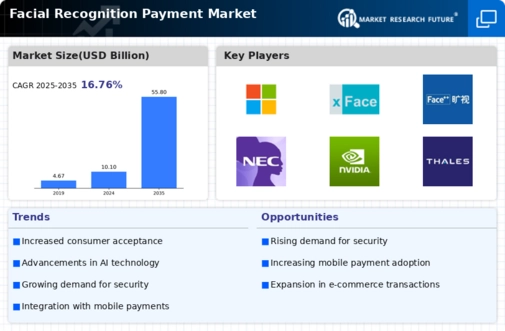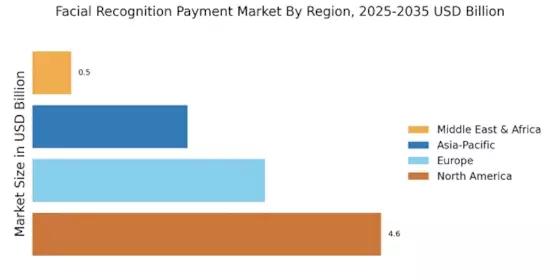Integration with Smart Devices
The integration of facial recognition technology with smart devices is a pivotal driver for the Facial Recognition Payment Market. As smart devices become ubiquitous, the potential for facial recognition to facilitate payments through smartphones, tablets, and wearables is expanding. This integration allows for a more convenient user experience, as consumers can make payments effortlessly using their devices. Market Research Future indicates that the number of smart devices is expected to surpass 50 billion by 2030, creating a vast ecosystem for facial recognition payment solutions. This trend not only enhances the functionality of smart devices but also positions the Facial Recognition Payment Market for substantial growth as more consumers embrace these technologies for everyday transactions.
Supportive Regulatory Frameworks
The Facial Recognition Payment Market is benefiting from supportive regulatory frameworks that encourage the adoption of innovative payment technologies. Governments and regulatory bodies are increasingly recognizing the potential of facial recognition systems to enhance payment security and efficiency. Initiatives aimed at promoting digital payment solutions are being implemented, which may include guidelines for the safe use of biometric data. As regulations evolve, they are likely to create a more favorable environment for businesses to invest in facial recognition technologies. This regulatory support is crucial, as it not only fosters innovation but also instills confidence among consumers regarding the safety of their personal information. Consequently, the Facial Recognition Payment Market is poised for growth as compliance with these frameworks becomes more streamlined.
Advancements in Artificial Intelligence
The Facial Recognition Payment Market is significantly influenced by advancements in artificial intelligence (AI) and machine learning technologies. These innovations enhance the accuracy and efficiency of facial recognition systems, making them more reliable for payment processing. As AI algorithms improve, the ability to recognize faces in various lighting conditions and angles increases, thereby reducing the likelihood of errors. This technological evolution is expected to propel the market forward, with estimates suggesting that the AI market in the payment sector could reach 7 billion USD by 2026. Consequently, businesses are more inclined to invest in facial recognition solutions, recognizing their potential to streamline operations and enhance customer experiences within the Facial Recognition Payment Market.
Growing Demand for Contactless Payments
The Facial Recognition Payment Market is experiencing a notable surge in demand for contactless payment solutions. As consumers increasingly prefer seamless and hygienic transaction methods, facial recognition technology offers a compelling alternative. According to recent data, the market for contactless payments is projected to reach approximately 1 trillion USD by 2025. This trend is driven by the convenience and speed of transactions, which are enhanced by facial recognition systems. Retailers and service providers are adopting these technologies to meet consumer expectations, thereby driving growth in the Facial Recognition Payment Market. The integration of facial recognition with mobile payment applications further amplifies this demand, as users seek efficient and secure ways to complete transactions without physical contact.
Rising Concerns Over Fraud and Security
The Facial Recognition Payment Market is also driven by rising concerns over fraud and security in financial transactions. As digital payment methods proliferate, so do the risks associated with them. Facial recognition technology offers a robust solution to mitigate these risks by providing an additional layer of security. Reports indicate that the global cost of payment fraud could exceed 40 billion USD by 2027, prompting businesses to adopt more secure payment methods. By implementing facial recognition systems, companies can significantly reduce the incidence of unauthorized transactions, thereby fostering consumer trust. This growing emphasis on security is likely to catalyze further investment in the Facial Recognition Payment Market, as organizations seek to protect their assets and customer data.


















Leave a Comment